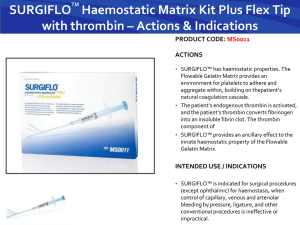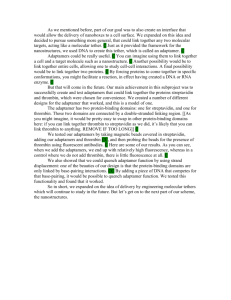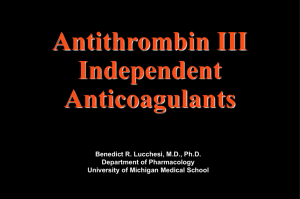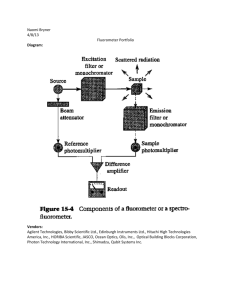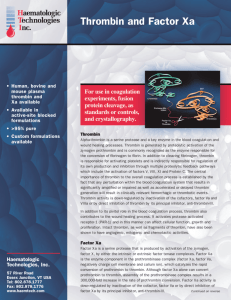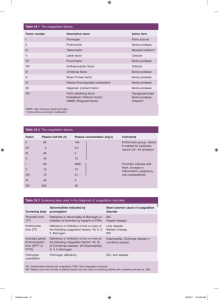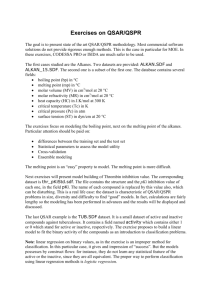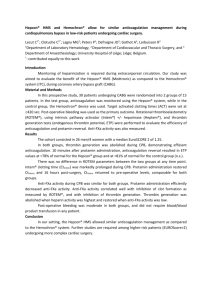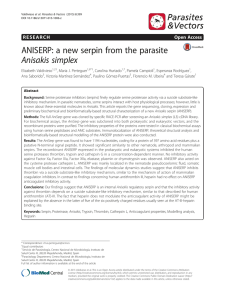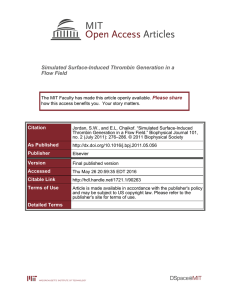Thrombin Poster Slides
advertisement
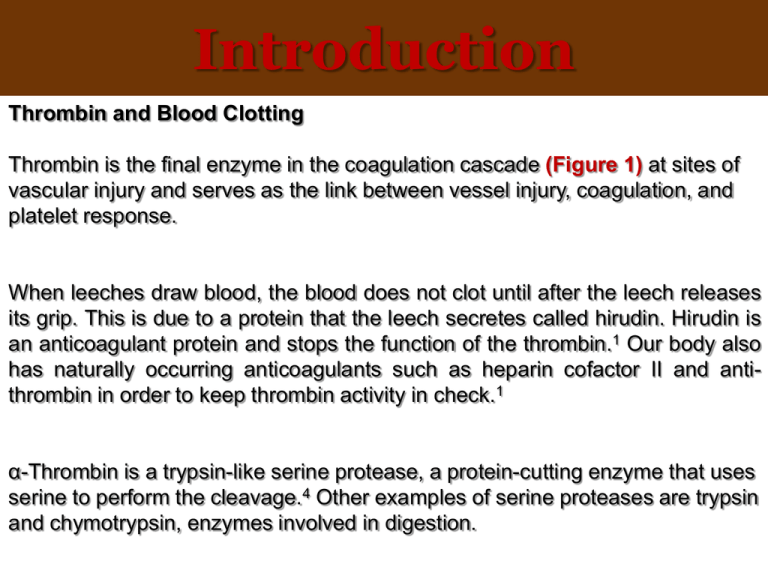
Introduction Thrombin and Blood Clotting Thrombin is the final enzyme in the coagulation cascade (Figure 1) at sites of vascular injury and serves as the link between vessel injury, coagulation, and platelet response. When leeches draw blood, the blood does not clot until after the leech releases its grip. This is due to a protein that the leech secretes called hirudin. Hirudin is an anticoagulant protein and stops the function of the thrombin.1 Our body also has naturally occurring anticoagulants such as heparin cofactor II and antithrombin in order to keep thrombin activity in check.1 α-Thrombin is a trypsin-like serine protease, a protein-cutting enzyme that uses serine to perform the cleavage.4 Other examples of serine proteases are trypsin and chymotrypsin, enzymes involved in digestion. Coagulation Cascade Figure 2: In the coagulation cascade, thrombin catalytically cleaves the bonds of fibrinogen into networks of fibrin to form the solid fibrin gel of a hemostatic plug or a pathologic thrombus. It activates platelets as well as the blood coagulation factors V, VIII, and XIII that are essential for formation of the blood clot. Crystal Structure Human α-Thrombin First crystallized by Bode et al (Human Thrombin). Heterodimer; disulfide linked; hydrophilic (Hydropathy Plot). Light (L) - 36 residues, 1 alpha helix Heavy (H) - 289 residues, 2 beta barrels, several alpha helices The active site is located in between the 2 beta barrels (Active Site). A conserved feature of trypsin-like protease is the presence of His406, Asp462, and Ser568 in the active site (Sequence Homology). Human α-Thrombin Hydropathy Plot Figure 3: A hydropathy plot for human thrombin, a plasma soluble blood clotting protein Active Site Sequence Homology Catalytic Mechanism Figure 4: Diagram showing interaction between fibrinogen A-strand and thrombin at thrombin's active site, including Ser568 and His406.5 Medical Relevance Venous and arterial thrombosis (blood clots) are one of the most common causes of death. Thrombin inhibitors stop the function of thrombin and prevent the formation of blood clots. Blood clots can travel through the body and cause several medical conditions ultimately leading to a heart attack.2 Hirudin – Inhibits thrombin by binding to exosite I and the active site, the area where fibrinogen binds.7 Hirudin Hirudin is the most potent and specific natural thrombin inhibitor. Hirudin consists of a polypeptide chain of 65 residues with three disulfide bridges. The three N-terminal amino acids of hirudin bind in the active site of thrombin to induce inhibition. Hirudin-Thrombin The C-terminal fragment of hirudin binds to exosite1 of thrombin making both the electrostatic and hydrophobic interactions essential for tight binding. Key electrostatic interactions: hAsp-55 with Arg-73 and hGlu-57 with Arg-75. A large number of hydrophobic interactions between thrombin and hPhe-56, hIle-59, hPro-60, hTyr-63, and hLeu-64 of the C-terminal fragment of hirudin are made upon binding as well. Mutagenesis Study Numerically, hPhe-56 makes the most contacts with thrombin, and its loss through replacement with alanine causes a decrease in the free energy of binding (Betz et al.,1991b). It was shown that hPhe-56 can be replaced with tyrosine without loss, but tryptophan seems to be too large. Replacement with branched amino acids (Leu, Val, Ile, or Thr) causes an even larger loss of energy. Thrombin-Hirudin References 1. 2. 3. 4. 5. 6. 7. 8. 9. Davie, E. W., Kulman, J. D. (2006) An overview of the structure and function of Thrombin. Semin Thromb Hemost. 32, 3-15. PMID: 16673262. Tanaka-Azevedo A.M, Morais-Zani K, Torquato R.J.S, Tanaka A.S. (2010) Journal of Biomedicine and Biotechnology. Di Cera, E. (2008) Mol Aspects Med. 29, 203–254. Kraut, J. Serine Proteases: Structure and Mechanism of Catalysis (1977). Ann. Rev. Biochem., 46, 331-358. Martin, P. D., Robertson, W. Turk, D.,Huber, R., Bode, W. Edwards, B.F.P. (1992) The Structure of Residues 7-16 of the Aa-Chain of Human Fibrinogen Bound to Bovine Thrombin at 2.3-A Resolution. The Journal of Biological Chemistry. 267, 7911-7920. Baum, B.; Muley, L.; Heine, A.; Smolinski, M.; Hangauer, D.; Klebe, G. (2009) J Mol Biol. 391, 552-64. Grutter MG, Priestle JP, Rahuel J, Grossenbacher H, Bode W, Hofsteenge J, Stone SR. 1990 Crystal structure of the thrombin-hirudin complex: a novel mode of serine protease inhibition. EMBO J. 9, 2361–2365. Pineda, A.; Carrell, C.; Bush, L.; Prasad, S.; Caccia, S.; Chen, Z.; Mathews, F.; Di Cera, E. (2004) J Biol Chem. 279, 31842-53. Rydel TJ, Tulinsky A, Bode W, Huber R. 1991 Refined structure of the hirudin-thrombin complex. J Mol Biol. 221, 583–601.
